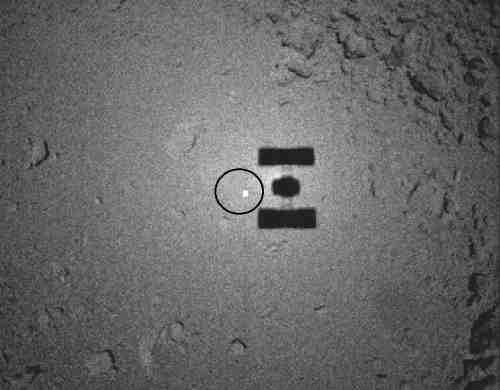[/caption]
No news yet if there are specks of asteroid dust in the Haybusa sample return container. JAXA has decided to postpone releasing any information, including publishing a detailed analysis of the particles that may have been collected. According to The Japan Times, JAXA said it is taking more time than originally expected to collect the particles because they are smaller than it was assumed they’d be. This provides some hope, however, that there is actually something of interest in the container.
Originally, JAXA had hoped to publish a report by September, but now it’s looking like December or later.
JAXA said it is going to take several hours to collect just one particle, which likely measures just a few thousandths of a millimeter in diameter. Munetaka Ueno, a senior JAXA official, said the agency wants to analyze the particles with extreme care because repeating the process will be difficult.
The original plan was for JAXA to remove the particles and then let researchers across the country for a more detailed analysis.
We waited seven years for Haybusa to fly to and then return home from asteroid Itokawa, so we should be able to wait a couple more months. Here’s hoping the particle extraction doesn’t encounter as many problems as the spacecraft had.
Source: The Japan Times


I’m sorry, but am I the only one that thinks that their sample collection mechanism was far more complex that it needed to be? Does anyone else feel like the Japanese were trying to be just a bit too clever with many of the aspects of this mission? Just stick a little grappling probe down to the surface, and haul up some dust. There – easy. JAXA should just hire me because clearly I’m awesome.
That is easier said than done. Your system has to ensure it is a correct distance from the surface. This would require remaining stationary with the asteroid, which means compensating for its weak gravity. None of that is at all particularly easy.
LC
The MINERVA microrover that failed due to the intervention of a Hayabusa automatic ascent maneuver was relying on the same 10 ug’s surface gravity of Itokawa.
At 10^-5 Earth gravity, the ~ 0.5 kg Minerva experienced a ~ 5*10^-5 N force, or roughly the gravity force a bean would feel here. But, to spill the beans: beans have no problem falling.
I agree with ASTROFIEND also how far away were they when the “dropped” the reflective target. Interesting concept in virtually zero gravity situation. Also, what light is producing the shadow? Please don’t say the sun as it was not in that position at that time.
Well, I guess one of the technicians in charge with collecting the dust particles sneezed during the operation, and now they are embarrased to say that JAXA is looking for the dust particles on the workshop floor. Not an easy task though, as they took in account the possibility that the particles in container were contaminants from earth, so it looks like the clean room is not that clean after all. Hopefully they analyze by December all the particles on the workshop floor (and select the extraterrestrial ones) and then we know if JAXA has collected the first pristine particles from an asteroid :))
Ya, the sun was in that position at that time! The projected shadow looks right. I mean if you have visual camera recording the approach, you don’t want to be looking into the sun do you? And yes it is difficult to scoop anything in zero G. May be they should have used some type of spiked projectile with cable for sampler? The projectile tip gets buried while the sample canister gets pulled up as satellite move away with some G force.
“Far more complex” is a judgment call.
If you look at japanese technology in general, they are masters of out-of-the-box solutions that allowed for, say, ion implanters and cheep copying machines that otherwise wouldn’t be or be much later. (Some blame it on the massive language handling, origami et cetera that infuse their culture with “brain games” and lateral thinking rewards.)
But space technology labor under a lot of specific constraints that makes for odd solutions all by themselves. Add on LBC’s list with cost, weight, vacuum, development, testing and reliability constraints. It is rather difficult to stand outside and second guess solutions then.
It seems to have worked, so “good enough” by that measure! But this was a first attempt, the goal measure of success was probably achieved in a long function list way before actual collection. So this was *awesome* – too. 😀
@Emilio
“spiked projectile with cable for sampler?”
Nice in theory but would it work?
* How hard is the surface?
* You eject the projectile, the spacecraft moves in the opposite way because of this.
* The cable itself can have unpredictable effects in the spacecraft.
The problem is that your proposal puts the spacecraft in an uncontrolled orbit and it might slap on the asteroid because of this.
@sboyd
What is the light? Look at the position of the solar panels. The sun is right behind the spacecraft. Which is logical, maximum solar power, best lightning for the asteroid and camera’s to analyse the distance since it is an automatic approach at a place no one has ever been.